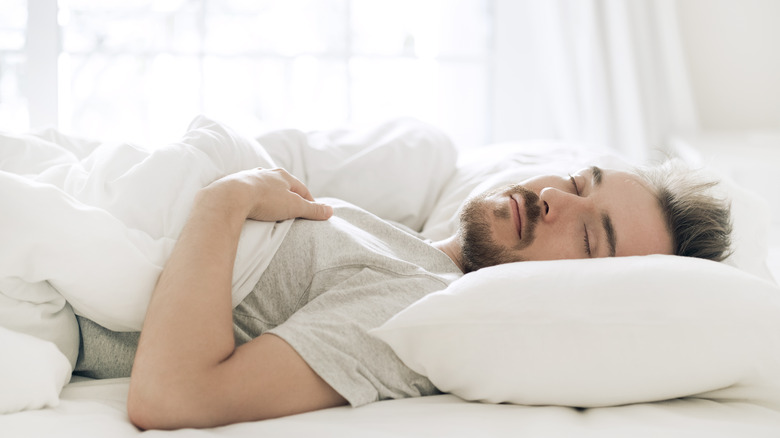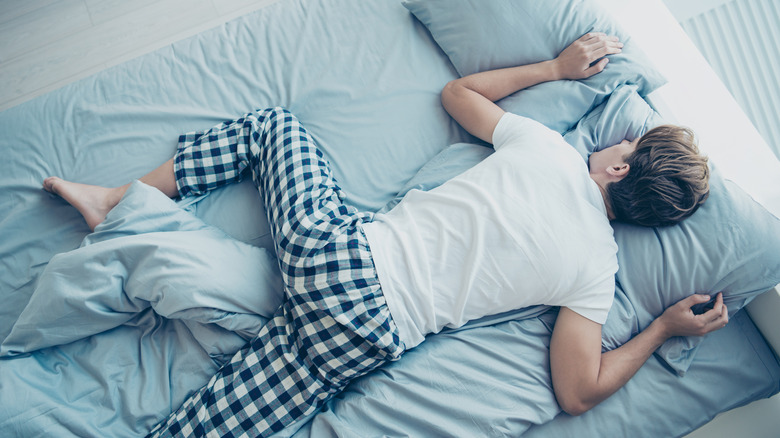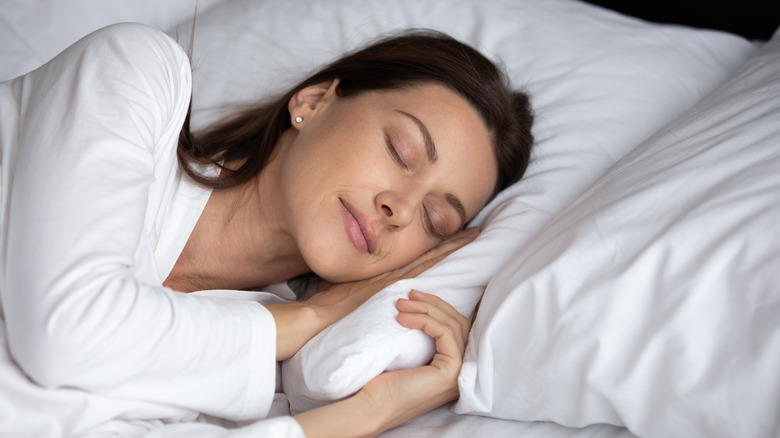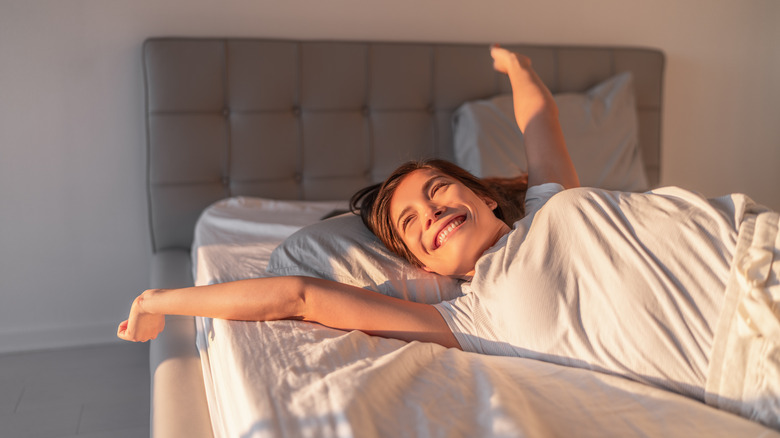You may have a favorite sleeping position that helps you drift off into slumber. Unless you’re a vampire, that position is one of three possibilities — relaxed flat on your back, curled onto your side, or snug on your belly. But falling asleep easily is not necessarily what defines a sleeping position that is good for your body for a solid eight hours. You need to consider how you are feeling the next day. Do you have aches and pains? Are you constipated or do you have other digestive problems? Are you exhausted?
The position you fall asleep in tonight will affect how you feel tomorrow. It’s possible your favorite position is not the right one for you if you experience joint pain, muscle stiffness, constipation (yes, it’s true), or lingering fatigue the next day. There are benefits and drawbacks to each position, although one seems to offer the most health advantages to the most people.
Which position is that? Here’s a possible hint. A study conducted in 2024, published in the journal, Nature and Science of Sleep, of over 600 male and female participants, ages 20 to 65, found that subjects spent 7.3% of their time in bed in the belly-down position, 37.5% of time sleeping on their back, and 54.1% of time sleeping on their side.
Read on for more details about which sleep position will have you feeling your best the next day.
Is back sleeping best for you?

Back sleeping is beneficial for those who suffer from hip or knee pain, arthritis, bursitis, or fibromyalgia, or experience a stuffy nose or congested sinuses when they lie down. Certified sleep science coach Bill Fish told Healthline that sleeping on your back helps keep the spine aligned, takes pressure off the shoulder and jaw, and reduces tension headaches. So if you have pain from injuries or chronic conditions, sleeping on your back may help alleviate it.
To make the position more effective, and train yourself to sleep on your back, slide a wedge pillow under your knees to put the spine in a neutral position; keep your legs hip-width apart and arms out to the sides to evenly distribute your weight on all joints; and consider placing pillows on each side to maintain the position. For a stuffy nose, prop your head up with an extra pillow (per Healthline), but avoid having your chin tilted toward the chest.
If you snore or suffer from sleep apnea, back sleeping is not for you. It allows the base of your tongue and soft palette to collapse to the back of your throat (per WebMD). If you’re intent on back-sleeping though, you can try to raise your head to reduce the chances of your breathing being affected, but achieving the right height is difficult without your head being vertical, according to CNET. It’s best to switch to side sleeping.
Bonus: There’s a beauty advantage to sleeping on your back. It protects your face from developing wrinkles caused by a pillow or gravity. Nice!
Should you sleep snug as a bug on your belly?

The short answer is no. Sleeping belly-down is not advised for several reasons. Fish explained to Healthline that most of the body’s weight is in the center. And when you’re lying belly-down, that weight pushes into the mattress and causes strain to the spine in the wrong direction, which can lead to back and neck pain. Sleeping on your stomach also puts strain on muscles and joints, causing soreness and fatigue the next day (per Healthline). What’s more, being in that position puts pressure on the respiratory system by requiring more effort to elevate the body against gravity in order to breathe (per Nature and Science of Sleep) and increases heart rate, neither of which helps you get a good night’s sleep (per Mic).
The only possible benefit to sleeping belly-down is that it helps the airways stay open and reduces snoring (per Johns Hopkins Medicine), but that is also accomplished by sleeping on your side, without the added negative effects to your body.
If you’re absolutely insistent on sleeping on your stomach, use a very thin pillow under your head, or no pillow at all, to avoid stress on your neck. You may also want to place a pillow under your hips to reduce the possibility of developing lower back pain. And pay attention to your limb position: Don’t bend a leg out to the side, which can hurt your back, or tuck your arms beneath your head or pillow, which can cause numbness and tingling.
Is sleeping on your side wise?

Shutterstock
It certainly is. In fact, lying on your side is the best sleep position for a variety of reasons. First off, it keeps the spine straight and aligned, Dr. Robert Hayden, an American Chiropractic Association spokesperson, told Mic. That’s not very surprising, but what is surprising is that side sleeping encourages brain health too, per Healthline. Snoozing on your side, rather than on your back or belly, helps clear from the brain what’s referred to as interstitial waste — debris produced by brain cells that can be toxic and prevent the brain from functioning normally (Harvard University blog). Getting rid of this waste helps reduce your chances of developing neurological diseases, such as Alzheimer’s.
The fetal position is the most popular sleep position overall, for good reason, as it helps with lower back pain, is safe and comfortable during pregnancy, and reduces snoring. If this is your favorite position, just be sure to keep your body loose and legs extended. A tightly curled fetal position, with knees drawn up, can interfere with deep breathing during slumber by restricting movement of the diaphragm, and may cause pain and stiffness in the morning.
Sleeping on your left side in particular has additional health benefits due to the effect of gravity on anatomy. It boosts the digestive system as gravity helps move waste through various parts of the colon to its final destination in the descending colon. What that means: a visit to the bathroom come morning. Sleeping on your left side may also reduce heartburn during sleep by keeping gastric juices lower than the esophagus.
Tips for the midnight thrasher

Shutterstock
If you find yourself struggling to get comfy during the night, no matter which position you fall asleep in, you’re probably experiencing poor sleep overall. Research has shown that men and younger adults move more during the night in terms of sleep position and readjustments of the arm, thigh, and upper back (per Nature and Science of Sleep). Moving frequently may not only cause you to feel tired the next day, it may also interrupt Stage IV of the sleep cycle, otherwise known as REM, which is when you dream. Not having enough REM sleep has far-reaching health implications, from weight gain to hypertension, according to Mic. It also interferes with the secretion of certain hormones that help repair the body’s tissues.
Dr. Hayden recommends that if you’re tossing and turning most nights, you should look at your stress level, and try to eliminate or at least reduce it by indulging in relaxing activities before bedtime, such as reading a book (instead of scrolling on your phone) or taking a warm bath.
If you’re a midnight mover and shaker, you may want to experiment with pillows so you fall asleep in and maintain a side-lying position. But keep in mind that while side sleeping seems to work best for most people, you don’t have to force yourself into it if it’s not comfortable for you. What matters is that you sleep soundly so you can get up the next day, refreshed and pain-free, to take on the world.



